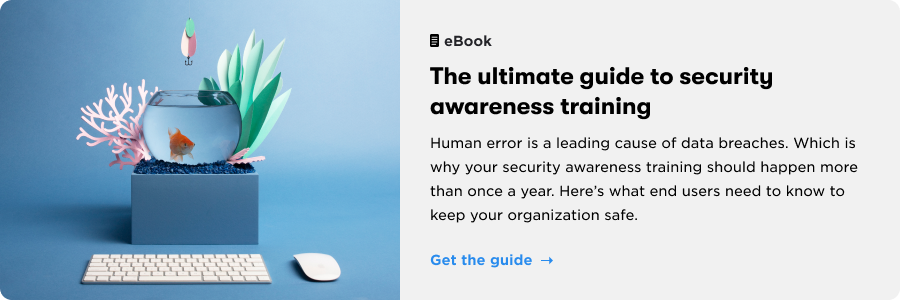No doubt, you’ve seen it before: you put up firewalls and anti-malware tools, update software and definitions, control access to sensitive data—and somehow, cyberthreats still get through to your users.
And 9 times out of 10, it’s thanks to human error.
Unfortunately for security execs, your organization is only as secure as your least secure user. You can put redundancies in place to guard against carelessness, but there’s no way to anticipate every data leak or breach.
So, how do you combat human error?
Hint: it’s in the title.
For employees, phishing training is an essential component of security awareness training because it proactively helps them correct risky behaviors—before they encounter a threat.
Education
Of course, simulated phishing alone won’t prevent human error. However, pre-phishing security training can educate users about common risks—and education is key to an effective faux-phishing program.

Here’s the thing. Scammers count on human error when they plot a phishing attack. But human error can also cause other security issues outside of phishing. Generally speaking, two kinds of user mistakes put data at risk, and it’s worth educating your users about both.
Errors of deception
Phishing falls under the category of social engineering scams. At its heart, social engineering is an attempt to deceive users into divulging sensitive information.
These scams may:
- Impersonate authority (a company exec, the police, the IRS)
- Leverage users’ fears (COVID test results, tech support issues)
- Play on users’ curiosity (social media tags or posts, clickbait articles)
Whether it’s a limited time offer or an urgent request from the CEO, almost all social engineering attacks pressure users to act (respond to the message, click a link, download a file).
In terms of education, the goal is to help users recognize scams when they come across them. While some legitimate messages may involve time-sensitive requests, play on users’ curiosity, or come from a company leader, users should be taught to verify this information independently before acting.
Errors of negligence
Honestly, this might be the harder type of mistake to prevent.
Negligent errors are those innocent mishaps that are caused by a temporary lapse in judgment—the kind of thing that happens when you’re busy or stressed or tired. (Think adding the wrong recipient to an email or failing to update your laptop.)
Good security awareness training addresses common habits that can put sensitive data at risk. Because these behaviors are so common, most users don’t even realize that they’re dangerous. But something as simple as adding an external colleague to an email thread can be considered a data leak.
In drawing attention to these behaviors, the goal is to help people be more aware of their habits and more intentional in their actions. While these errors aren’t specifically targeted by phishing training, they’re still worth including in your security awareness training.

Testing
Yes, security training alone won’t prevent human error. So—once you’ve taught users about habits and threats that put them at risk of leaking data—it’s time to put their education to the test.
Simulated phishing is a chance to put users face to face with social engineering threats and see how they react. Ideally, they’ll remember their training and see through the ruse, but some may not—and that’s okay.
Remember—this is simulated phishing, a sandbox environment of sorts. Users can make mistakes here and not suffer the repercussions they would if suspicious emails were the real deal.
Obviously, the goal is to help users learn from their mistakes so that when they are confronted with a malicious social engineering attack, they know what to do (and not do). That’s why repeated educating and testing—and not just relying on annual corporate security training—is so important.
The One-Two Punch
At the end of the day, preventing human error is an uphill battle. After all, human error is only natural and something we all struggle with.
But pairing education and phishing training for employees is the secret to changing user behavior. Together, these approaches help users think twice before acting on a social-engineering scam.
With repeated training and testing, users will develop safer habits, like quickly analyzing emails, links, and attachments—instead of clicking away with wild abandon or happily sharing sensitive info with anyone who asks.
Bonus: if your education involves general security awareness training, users will develop additional cyber-safe habits that will strengthen your org’s defenses from the inside out.
Basically, security awareness and phishing training for employees is kind of a big deal, and we’ve only scratched the surface here. If you’re serious about preventing human error, check out our free eBook, The Ultimate Guide to Security Awareness Training.



